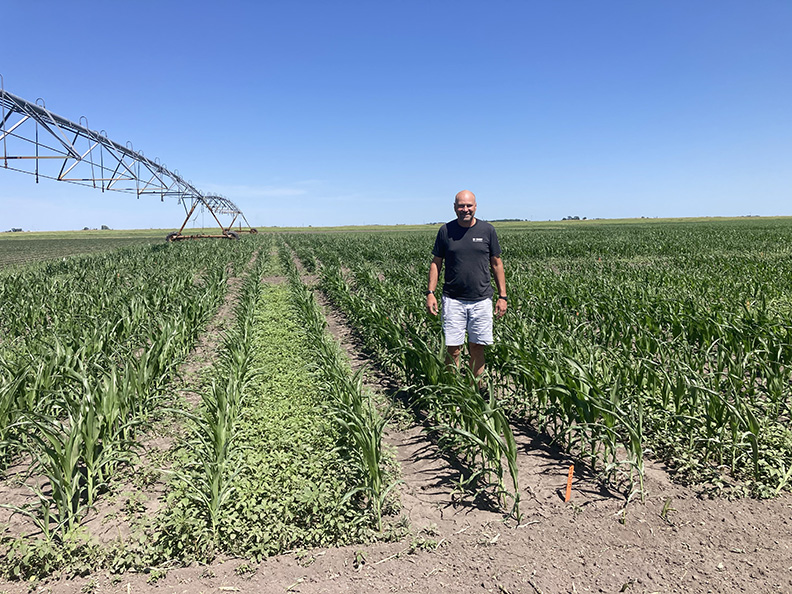Weed Control Perspectives
Contact
University of Arkansas System Division of Agriculture
Cooperative Extension Service
2301 S. University Ave.
Little Rock, AR 72204

Weed Control Perspectives
During the last week I’ve been taking a tour of farm country in the upper Midwest. Along the way I visited two nephews, both Ph.D. weed scientists who have been working in the field for about 25 years. I wanted to get their reflections on the changes they have seen in their careers and what the future may hold for commercial agriculture.
Sons of my oldest brother Karl, Tracy and Troy grew up on a wheat and cattle operation in central Oklahoma. Tracy received his Ph.D. from the University of Arkansas in Fayetteville while Troy went to Kentucky. Starting work in the mid-1990s, both now work for big, German, multi-national corporations with an expansive portfolio of products and services aimed at “Big Ag.”

They were a part of the vanguard of scientists who launched their careers as agriculture was experiencing a sea change that led to producing more yield with less input. As a reference point, Roundup Ready soybean varieties were approved in the US in 1996, corn a year later. Using soybeans as an example, average per-acre yields have grown from 32 bushels in 1993 to about 50 bushels per acre today.
The reasons for this spurt in production are many including changing farming practices (switching to no or minimum tillage), higher yielding varieties, better weed control approaches, and especially for corn and cotton, use of genetically modified lines, known as GMOs, that have built-in insect resistance.
In 2024, the herbicide glyphosate, or Roundup as we mostly know it, will celebrate its 50th year in the marketplace. It was a game-changing herbicide when I was receiving my Ph.D. in the early 1970s. Its broad spectrum of activity, post-emergence effectiveness on everything from seedling weeds to cut tree stumps and its long track record of safety — regardless of what some trial lawyers have been able to convince juries - made it useful in managing weeds in many situations, especially in GMO Roundup Ready crops.
Since the introduction of Roundup Ready crops, about 90% of the soybeans and 70% of the corn crop acreage take advantage of these traits. Troy told me that during the first decade of using this new technology, weed control was easy. Even if you didn’t get great pre-emergence control, escapes could be easily managed by an over-the-top spray of glyphosate. Then resistant weeds began appearing — especially water hemp and Palmer’s amaranth says Tracy — and new strategies had to be devised.
Tracy says that crop lines today stack resistance to three post-emergence herbicides in their genome, allowing farmers to target problem weed populations with chemicals that will eliminate them. He says that CRISPR gene editing techniques are a promising approach that will allow introduction of lines with specific traits that can do everything from increase yields to provide targeted protection from pests. Regulators here and in Europe are still debating where crops with edited genes fall into the regulatory framework.
Troy tells me that the evolutionary sequence going on in weed control now involves “see and spray” equipment. Using digital cameras, high-speed computers and solenoid-controlled spray heads, this equipment can identify and then “spot” spray escaped weeds in the field while driving across the land at 15 miles per hour. He says that the next generation of see and spray equipment may be smaller, autonomous equipment that can operate at any time of the day or night when there is no wind. But spraying after the weeds come up will never be the goal, says Troy. Effective pre-emergence herbicides will likely always remain the first line of defense in a weed control strategy.
Tracy says one of the big changes he’s seen happen is what he called “geospatial farming”. Using everything from satellite imagery, detailed soil mapping and other production-related data points, a precise prescriptive planting and management plan can be developed that takes advantage of the smart technology built into modern farm machinery. Hopefully, this kind of detailed farming plan will lead to the overall goal of producing higher yields with less input.
Driving through this beautiful farm country, I couldn’t help but wonder about the health of the family farm. In 2021, the average farm size in the U.S. was 445 acres. That statistic is pretty meaningless. Instead, if we look at farms based on income, small farms with less than $250,000 in annual income make up about 80% of the farm population. Very large farms (a designation used by the USDA) have an income of more than $500,000 and average about 2,100 acres in size. Many of the big farms in the country through which I traveled - often operated by siblings or father/children operators - have more than 10,000 acres in production.
While many of the whiz-bang technologies are initially aimed at the big farming operations with deep pockets, they usually filter down in such a way that even the smaller farmers can find a way to use them.